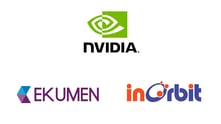InOrbit Brings RobOps to Simulations Powered by NVIDIA
Simulations have been a potent tool in robotics for some time now. Companies particularly rely on sims for reinforcement learning to train robots. Effective simulations can help drive continuous improvements in production workflows, orchestrate robots and other technologies, and mitigate the often costly impact of traffic jams. While many robotics companies use simulation tools, nothing provides the dynamic opportunity to visualize robots in such an exciting way as NVIDIA’s Isaac Sim™. Today we’re thrilled to unveil an integration of this powerful simulation tool with the InOrbit RobOps platform.
 As we announced in today’s press release, InOrbit and collaborators at NVIDIA, and Ekumen, a leading provider of advanced software development services with deep expertise in simulations, have brought RobOps to simulations. Leveraging NVIDIA Isaac Sim™ extensible robotics simulator powered by NVIDIA Omniverse™ to model complex environments and robot behaviors that closely match the real world, InOrbit is blending reality and simulation for robot deployments. This underscores how simulations, when coupled with the right tools and operational best practices, provide users the capability to harness data consistently across both physical and simulated environments, ensuring operational efficiency.
As we announced in today’s press release, InOrbit and collaborators at NVIDIA, and Ekumen, a leading provider of advanced software development services with deep expertise in simulations, have brought RobOps to simulations. Leveraging NVIDIA Isaac Sim™ extensible robotics simulator powered by NVIDIA Omniverse™ to model complex environments and robot behaviors that closely match the real world, InOrbit is blending reality and simulation for robot deployments. This underscores how simulations, when coupled with the right tools and operational best practices, provide users the capability to harness data consistently across both physical and simulated environments, ensuring operational efficiency.
InOrbit has launched a dedicated webpage that explores this integration more, but what really crystalizes the significance of this announcement is the demo video of the integration in action.
This first-of-its-kind demonstration shows a virtual Robot Space that closely matches the company’s real Robot Space located in the heart of Silicon Valley. Moving beyond a traditional digital twin, this integration sees multiple simulated robots from various vendors matching their real-world counterparts carrying out the same exact missions.
This showcases how end users with complex robot operations can use the same platform in both the real world and simulation, allowing them to test in sim first, then run the same missions in the real world, get consistent analytics, easily tweak missions, and go back to the simulation, to compare and optimize performance.
This work continues to bridge the Sim2real domain gap between cutting-edge AI-powered robotics technology and real-world applications at scale. We’re excited about today’s launch and invite everyone to continue exploring.
